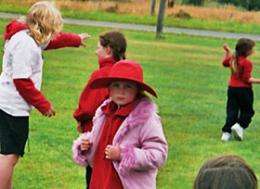More government responsibility needed in making schools 'sun-smarter'

Central government needs to take more responsibility for ensuring that New Zealand children are sun-safe while at school, according to University of Otago researchers.
In a study examining changes in sun protection between 2005 and 2009 at 189 randomly selected state primary schools around the country, Cancer Society Social & Behavioural Research Unit researchers found that there has been progress, but much room for improvement remains.
Schools in the Auckland and Northland regions showed the smallest average improvement across 12 criteria relating to sun protection, while schools in Waikato/Bay of Plenty showed the greatest, followed by Wellington and Otago/Southland.
The 12 criteria are from the Cancer Society's NZ SunSmart Schools Accreditation Programme (SSAP) and relate to school policy, information provision, hats, other clothing, 'play in the shade', sunscreen, staff role modelling, curriculum content, event planning, outdoor activities rescheduling, shade provision and policy review.
Study lead author Associate Professor Tony Reeder says that across all 189 schools the greatest areas of improvement between 2005 and 2009 were in the criteria of 'play in the shade' (rising from 76% of schools to 90%), sunscreen (66% to 80%) and hats (61% to 74%).
"We found that encouraging use of sun protective clothing remained the weakest area for schools; only 43% in our study had met this criterion by 2009. The next weakest was in providing or working towards adequate shade in school grounds through trees or shade structures, with only 52% meeting the requirements," Professor Reeder says.
The cost of shade development was reported by 57% of schools as an obstacle in addressing sun protection; the cost of sunscreen as an obstacle by 31%; and limited support of parents by 13%.
By October 2009, only 56 of the schools in the study had applied for SunSmart accreditation. Of the 133 schools that had not applied, the most common perceptions of what would encourage application were 'more information about the programme ' (61%) and 'better resourcing for schools' (30%).
The study authors conclude that "there is a need to assist schools in strengthening their sun protection policies and practices, overall, but especially regarding clothing, shade and better utilisation of available curricular materials".
Associate Professor Reeder says that sun protection at school is a basic health and safety issue for students, given that a person's sun exposure in the early years of life influences to a substantial degree their lifetime potential for melanoma skin cancer.
"Yet, as we note in our study, it has become largely the responsibility of a charity, the Cancer Society of New Zealand, to introduce and sustain health promotion efforts in this area.
"Among our new findings is that positive change is clearly shown in schools which have worked with local Cancer Society staff. We question though whether it should be a non-governmental group's role to shoulder the burden of achieving and sustaining universal uptake of SunSmart practices across all state and state-integrated primary schools.
"We believe public agencies such as the Ministries of Education, ERO and the Ministry of Health need to start taking a similar level of responsibility for sun protection as they do for other health and safety issues in schools."
The study results are available online and will be published in the October issue of the Oxford University Press journal Health Education Research.















